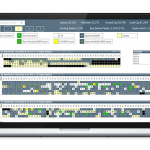


Cold Storage warehouse management – covering the entire storage to delivery including services like processing, packaging and transport of goods via specialist refrigerated logistics providers – comes with a unique set of challenges. And being foodstuffs, many of these challenges are critical, as they relate directly to the product condition and how it arrives in a safe condition to the consumer.
Operating at temperatures as low as -28°C results in several challenges. One of the key requirements in cold stores is to reduce energy costs associated with maintaining such low temperatures. Drive-in racking and mobile racking are common features to maximise chamber storage capacity however they can present operational issues.
Traceability:
Accurate traceability data for product location – in transit or in a warehouse rack – relates to customer satisfaction and inventory metrics. When temperature changes accurate location information is key. With some products like fresh produce requiring additional control of variables like humidity and CO, accurate documentation is also critical. Validation for HACCP (food industry Hazard Analysis & Critical Control Point) or ISO 22000 systemscan can be difficult or impossible without accurate data.
Food Spoilage:
Regulating temperatures in line with stored food stock can be challenging as products require different temperature and humidity levels. Previously, temperature monitoring has been left viewed as a manual process managed relying on operator experience – and they need to be physically at the warehouse to monitor and manage the systems.
In a multi-commodity cold storage warehouse one location might, say, store milk, dry fruit, vegetables and fruit to increase efficiency for each chamber. This results in cost and space optimisation. Simultaneous energy levels result in a controlled atmosphere within storage and ripening chambers with specific conditions being met to maintain high perishability items and to allow ripening as needed by chamber.
Product & Rack Labelling:
All important barcode labelling design is key as these connect the products with the IT systems managing receiving, storage, retrieval, and shipping but in a cold store the labels need to be of a specific type to avoid costly label failure from unidentified products. Effective printer and label technology is a business-critical element of the traceability pipeline and rack labelling poses potential issues as warehouses may be incorrectly identified.
 Our WMS Advanced Warehouse Management Software manages ancillary activities such as Blast Freezing & Tempering. Temperature probes inserted into the stock within the blast freezer, or tempering room, can minimise the time products stay in these locations by automatically generating a WMS extraction command by taking an electronic feed from the probe when the product reaches the required temperature – instead of using a fixed period approach. This saves energy and optimises storage capacity.
Our WMS Advanced Warehouse Management Software manages ancillary activities such as Blast Freezing & Tempering. Temperature probes inserted into the stock within the blast freezer, or tempering room, can minimise the time products stay in these locations by automatically generating a WMS extraction command by taking an electronic feed from the probe when the product reaches the required temperature – instead of using a fixed period approach. This saves energy and optimises storage capacity.